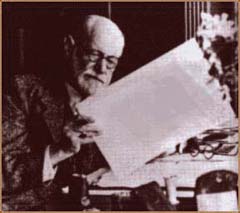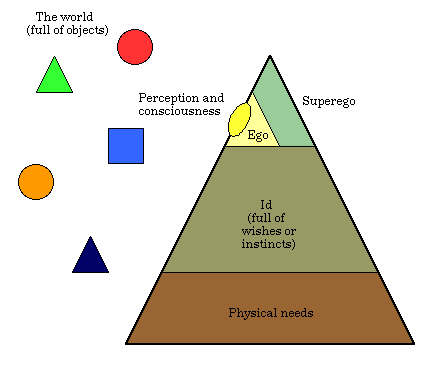FREUD BIOGRAPHY & KEY PSYCHOANALYTIC TERMS

1856 Born in Freiburg (now Czech Republic) to Jacob Freud
(1815-1896) & Amilia Freud (1835 - 1930)
1860 Family moves to Vienna (then part of Habsburg Empire, now
Austria)
1873 Enters Vienna University as a law student
1877 Works with Josef Breuer (patient called Anna O.)
1881 Graduates as a medical student
1882 Works at Vienna General Hospital
1884 Starts to experiment with cocaine
1885 Studies under Jean Charcot in Paris who, who uses hypnosis to
treat hysteria. 4 main characteristics of hysteria:
(1). Almost psychotic indifference to gross bodily dysfunction (2)
Primarily female (3) Primarily from middle & upper-middle
class families, (4) Onset typically during adolescence or early
20's. Example: Anna O. (Bertha Pappenheim) who called the therapy
process with Breuer the "talking cure". Freud learned 3 things:
neurotics suffer from reminiscences (memories); memories can be
unconscious; & memories have a common core.
1886 Marries Martha Bernays
1895 Publishes Studies on
Hysteria with Josef Breuer
1896 Coins term "Psychoanalyse" (In German, "psyche" = soul).
1897 Freud's father dies & Freud starts his self-analysis.
1900 Publishes The
Interpretation of Dreams (Die Traumdeutung); Ida Bauer, patient he later identifies as Dora, stops treatment for hysteria
1901 Psychopathology of
Everyday Life; first draft of Dora
1902 Becomes Assoc. Professor at Univ. of Vienna
1904 Ends relationship with Fliess, who accuses Freud of
plagiarism.
1905: Fragment of an Analysis
of a Case of Hysteria (Dora)
1907 Freud & Jung meet in Vienna
1909 Forms International Psychoanalytical Society with Carl Jung
as its first president. Comes to US to give a series of lectures
at Clark Univ.
1913 Totem and Taboo
1914 WWI
1920 Beyond the Pleasure
Principle; daughter Sophie dies of influenza
1923 The Ego and the Id
1930 Civilization and Its
Discontents (Das
Unbehagen in der Kultur)
1931 2nd edition of Civilization
and
Its Discontents sold out
1933 Hitler Chancellor of Germany; Nazis burn his books in Berlin
1938 Germans invade Austria; Leaves Vienna for Paris and then
London
1939 Moses and Monotheism;
dies in London after asking for a lethal dose of morphine. In his
last 20 years he has 33 operations for cancer of the jaw.
1976: Hélène Cixous, Portrait of Dora
2002: Dora the Opera premiers
PSYCHOANALYTIC TERMS

I. Id, Ego, Superego
(Conceptual image from http://www.ship.edu/~cgboeree/freud.html; TERMS partially adapted from: http://oldsci.eiu.edu/psychology/Spencer/Freud.html)
A. Id - from the German das Es
("it"). It contains the instincts: (1) Life - Sex (Eros) &
self-preservation (2) Death.
Four Characteristics: (1)
Source - somatic process in body (2) Energy - rooted in
somatic deprivation; libido = "fluid-like substance of
biological origin". (3) Aim - satisfaction, tension-reduction
(4) Object -objects in external world that make satisfaction
possible.
B. Ego - from German das Ich
("I"). Famous quote: "Where the id ("it") was, there shall
become ego ("I").
Two functions: (1) Deal
effectively with external world (2) Behave defensively to
translate instinctual demands into expressions not
inconsistent with the demands of the superego.
C. Superego - from German das
Überich ("over-I"). It is differentiated from the ego,
& is partially unconscious. It contains the traditional
values & taboos of society as interpreted by the parents
and makes guilt possible.
Two parts: (1) Conscience -
cultural bans (the don'ts) (2) Ego ideal - positive acts (the
do's).
II. Stages of Human Development
1. Oral Stage - first year of
life ( ‡18 months)
2. Anal Stage (18 mo ‡ 3-5)
3. Phallic Stage (3-5 ‡ 6-8)
4. Latency Stage (6-8 ‡
puberty)
5. Genital Stage (puberty ‡
death)
III. Evaluation of Freud’s
theories
A. Criticisms:
1. Freud overemphasizes
infantile sexuality and early personality formation, thus
failing to consider adult personality changes.
2. Freud overemphasizes the
power of unconscious and makes an artificial, structural
division of personality (id , ego, superego).
3. Freud’s theories stem from
analysis of bourgeois, nuclear families in turn-of-the-century
Vienna and are no longer applicable to the multi-layered,
postmodern family life.
4. Freud’s theories about
women, whose sexuality he labeled man’s “dark continent,” are
based on the assumption of women’s phallic envy.
B. Contributions
1. Today we accept, from Freud,
that people are irrational.
2. Owing to his
exploration of the unconscious, humans’ motives are suspect.
3. Freud, along with Darwin,
emphasizes the animal nature of man and indicates that human
nature is what we are to rise above.
4. In contrast to the
eighteenth- and early nineteenth-centuries, when children were
treated as ‘small adults’, Freud raises the importance of
infancy & childhood.
5. Although his studies of
‘hysterics’ were gender-biased, Freud asserts that physical
symptoms can have psychological causes (Psychosomatic medicine
& Psychophysiology)
6. Founder of a new profession,
psychoanalysis.
Sigmund Freud, "The Uncanny," in The Standard Edition of the
Complete Psychological Works of Sigmund Freud, ed. &
trs. James Strachey, vol. XVII (London: Hogarth, 1953), pp.
219-252 (BF173.F68 in Davidson Library).
"Uncanny" is translated from "unheimlich," meaning haunted
(literally--not homey)
From Professor
Warner/Transcriptions
Project: Uncanny = effect comes from the supervening of the
earlier unconscious event upon a later one; the subject
experiences something as that which is both strange and familiar,
odd but intimate, alien but all too "close." Freud suggests that the
most strange, eerie and scary comes not from what is far away
from our experience and feelings (the exotic, foreign, the
utterly new and alien) but from what is close to home, the
private and the familiar which has been rendered secret through
repression, but then returns.
Suggested links:


